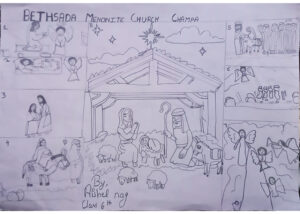Editor’s note: In this six-part series for Canadian Mennonite, Kara Carter, lead pastor at Wellesley Mennonite Church in southern Ontario, will explore some of the things she learned while earning her PhD in pastoral leadership.
Through examinations of the lives of pastors in Mennonite Church Eastern Canada, she identified barriers that risk keeping a missional church “stuck” as well as “burning bush” places that reveal the presence of God.
In the mid-1990s I served on the building committee in my congregation. Our mandate was to oversee the design and construction of a new sanctuary and office.
During one meeting, we wrestled late into the night. We were at a critical stage of decision-making. How large do we build? What seating capacity is needed? What projection for growth should we consider?
After a lengthy and unfruitful discussion, one wise member suggested we invite the president of the construction company to meet with us. I recall with clarity the president’s unhesitating response to our dilemma: “Build it and they will come.”
For decades, “build it and they will come” was a successful story for the church in North America, steeped with meaning, beliefs, expected outcomes, assumptions and more. Not only has this predominant congregational story become a limiting narrative, but it has also become a problematic story for a missional Mennonite church.
Today, while the language may be different, this story continues to be told. Perhaps it sounds like this: “Let’s launch a new program to strengthen children’s and youth ministries!” Or this: “Let’s ramp up music in worship!”
Deeply embedded in this story is the expectation that if we work hard enough, if we change our programs, if we get worship “right,” the community will be prompted to “come,” because we have something they need. We expect that the congregation will grow. Growth will be tied to our efforts. Neighbours will stream through our doors.
Could this be anything but a “stumbling block” story that risks keeping the church stuck from moving forward as God is doing something new among us?
As disciples of Jesus, rather than look to our neighbours or culture as problematic, our liberating God is inviting us to look within and reflect upon our congregation’s predominant stories.
What values, worldviews, meaning and more can we identify as we tell our predominant stories? A predominant story may be rooted in a congregation’s founding, a significant transition or conflict, or a particular ministry or loss. Stories are containers of information, meaning and theology. What might we unearth as we pay attention to the stories we tell and live into?
As humans, we live storied lives. As Christians, we locate ourselves within God’s unfolding story of salvation and redemption. Stories provide a framework to understand lived experience. They also inform future action. The process of telling and re-telling predominant congregational stories uncovers limiting narratives as well as burning bush places, revealing the presence and activity of God.
The church has a sacred story that has been, and continues to be, written by God, the Master Storyteller. Faith communities live into this sacred story, interpret this story, make meaning of this story and live into this story in relation to other stories. Now more than ever, it is sacred work for congregations to identify their predominant story, to communicate their story well, and to embody their story as co-creators with God.
Reframing stories, challenging limiting stories and living deeply within the power of story not only shapes new stories but also creates new pathways, enabling the church to move forward into unknown sacred spaces.
I have a pastoral colleague whose congregation travels from many different communities to participate in worship and the life of the church. He once told me, “Mennonites tend to value their community almost above all.”
My colleague suggests his congregation’s predominant story focuses on “community”—church members care deeply about one another. At the same time, they realize they are perhaps too inwardly focused. Church members desire to connect with the people in the neighbourhood surrounding the church, but there is hesitation to “disrupt the harmony in our conformity.”
Stories reveal tensions and competing priorities as well as strengths and gifts. Re-storying does not involve discarding communal values but is rather an opportunity to be open to the inspiration of the Holy Spirit, who disrupts, breathes new life and inspires God’s people to take new pathways.
My colleague’s congregation wants to create a prayer labyrinth on church grounds with the hope that it will be accessible to the neighbourhood. How might this dream be a step of re-storying “community” for the congregation?
What an exciting journey of faith to be the utensil in God’s hands, co-creators with God, writing new stories of hope.









Leave a Reply
You must be logged in to post a comment.